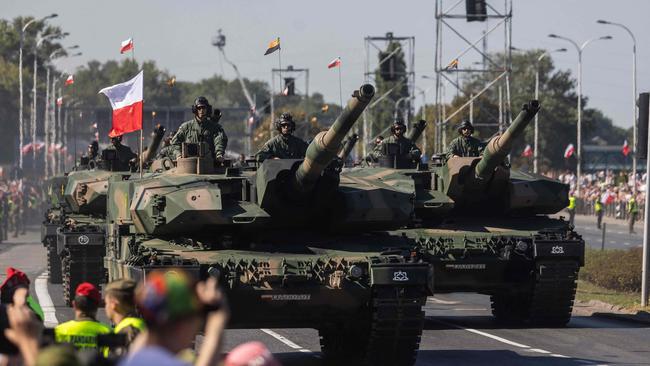Warsaw doubles size of army to counter Russia
In less than 10 years the Polish armed forces have roughly doubled in size, with the ultimate goal being to build the largest army in Europe.

The streets of central Warsaw rumbled with M1 Abrams tanks from America, K2 tanks and K9 self-propelled howitzers from South Korea, Himars rocket launchers and Patriot air defence systems, while F-16 fighter jets flew overhead in formation.
The parade, held on the anniversary of Poland’s heroic victory over the Red Army in the 1920 Miracle on the Vistula, was not only the country’s largest since the Cold War. It was also the coming-out party for the most rapid and ambitious military expansion that mainland Europe has seen in decades.
In less than 10 years the Polish armed forces have roughly doubled in size from 95,000 to 200,000, including 148,000 active regular personnel and a 38,000-strong territorial defence force established in 2015. The ultimate target is a total strength of 300,000, which would give Poland comfortably NATO’s largest land army in Europe.
The plan is to build up an inventory of 1600 main battle tanks, including about 1000 from South Korea alone: more than Britain, France, Germany, Spain and Italy put together. This year defence spending is projected to rise to well over 3 per cent of GDP. Some calculations suggest it could top 4 per cent, which would be the highest in NATO.
Mariusz Blaszczak, who was the chief architect of these reforms as the defence minister from 2018 until the end of last year, is blunt about their purpose. “We are doing this to create such a [level of] deterrence that Putin will be discouraged from attacking Poland,” he told The Times in an interview.
Leaders across Europe are increasingly worried that the continent is in no position to defend itself without American support, after three decades of paring back national defence budgets in the so-called peace dividend that followed the collapse of the USSR.
Over the weekend these concerns were stoked by Donald Trump, who told a rally that he would actively “encourage” Russia to attack any European NATO members that were “delinquent” on their military spending. On the same day Jens Stoltenberg, the secretary-general of NATO, told Welt am Sonntag that Europe needed to “arm itself for a possibly decades-long confrontation” with Russia.
Mr Blaszczak said it was high time for the other Europeans to do their bit. “I realise that the huge outlay on the military is a massive budgetary burden,” he said. “But we are at such a sensitive moment in the history of our continent that no one should doubt that investment in defence cannot be spared.”
The Polish politician, who is now the parliamentary leader of the opposition Law and Justice (PiS) party, reserved particular criticism for Germany, which he said had made an “insufficient” contribution and had in recent months been “only pretending to offer military aid to Ukraine”.
While Mr Blaszczak’s comments continue a long-running feud between PiS and Berlin, they also reflect a wider sense in Poland that its western European neighbours ought to have anticipated the danger many years earlier.
The MP points out that as far back as the Russian invasion of Georgia in 2008 Lech Kaczynski, then the president of Poland, said: “Today Georgia, tomorrow Ukraine, the day after tomorrow the Baltic states; and then maybe it will be time for my country.”
Poland’s rearmament program began in earnest at the end of 2018. It has two central goals. The first is to bind in the US as Poland’s primary security guarantor by doubling defence spending and ordering copious amounts of advanced American kit: 366 M1 Abrams tanks, 486 Himars multiple launch rocket systems, at least 32 F-35 combat aircraft.
The second and more significant dimension is scale. While western Europeans ploughed billions into hi-tech but enormously expensive systems known in military jargon as “exquisite platforms”, Poland recognised long before the full-scale Russian invasion of Ukraine that what would really count in a European land war was sheer mass.
“Many self-proclaimed experts argued that modern war would be fought mainly in cyberspace or using light infantry and unmanned systems,” Mr Blaszczak said. “However, as reality has shown, these were wrong … Ground troops are still the most important core element of the armed forces.”
As Britain and Germany know from bitter recent experience, setting recruitment targets is one thing, but hitting them can be quite another. Part of the solution in Poland has been simply to throw money at the problem. The basic salary for an army soldier has risen by 82 per cent over the past decade.
Yet Mr Blaszczak said an equally important factor had been sending the recruits out into society to put a human face on the armed forces. “Instead of costly media campaigns, soldiers met the public, took part in picnics and meetings, and gave interviews. Simply speaking, soldiers were very active.”
The new Prime Minister, Donald Tusk, who ousted the PiS government shortly before Christmas, has promised to sustain the high level of defence spending. Yet he has also made several notable changes. A number of senior defence personnel perceived as too close to PiS have been defenestrated.
Mr Tusk has hinted that he could scrap the previous government’s plan to build a new “mega-airport” near Warsaw, designed to play an important role in Europe’s military logistics. Most significantly, he has also ordered a review of the vast military hardware orders from South Korea to determine if they are value for money.
The Times



To join the conversation, please log in. Don't have an account? Register
Join the conversation, you are commenting as Logout